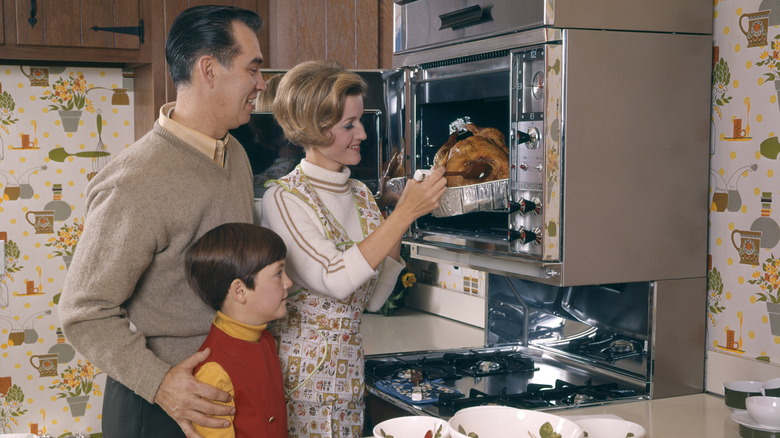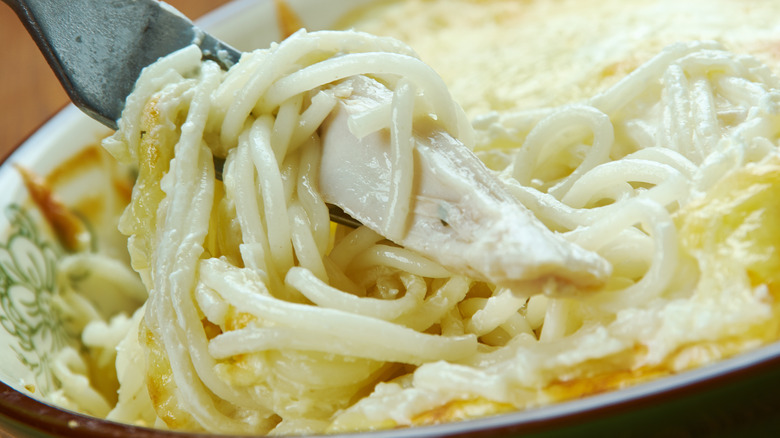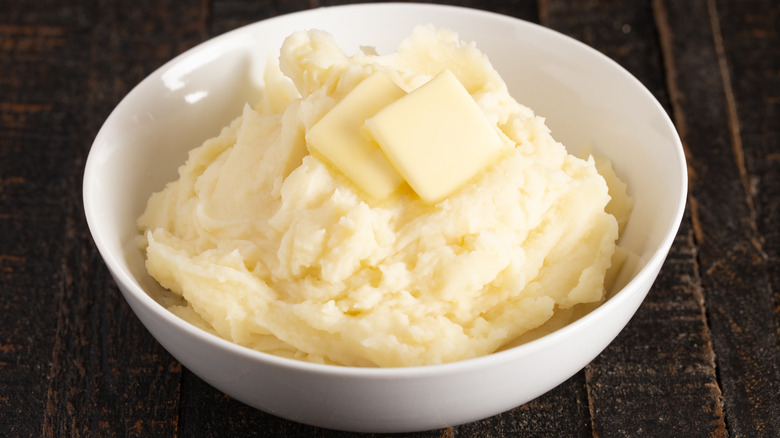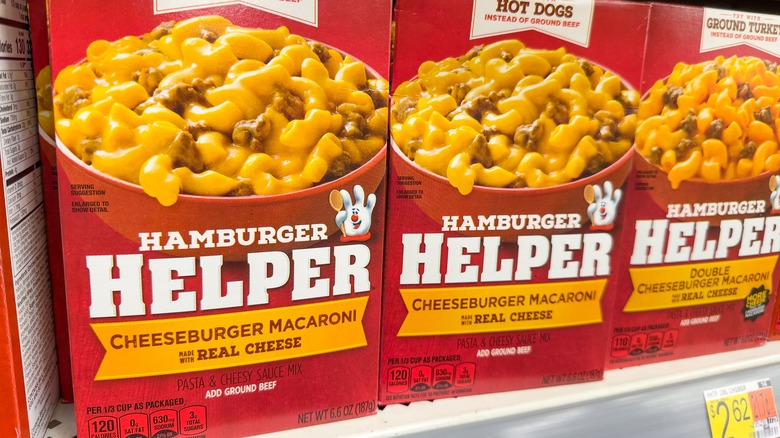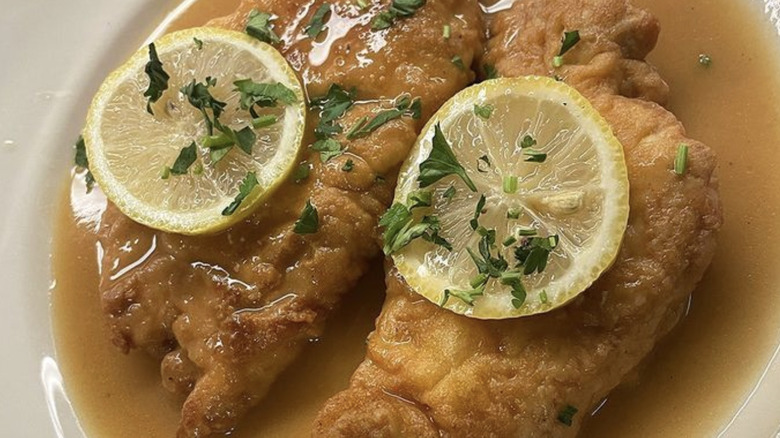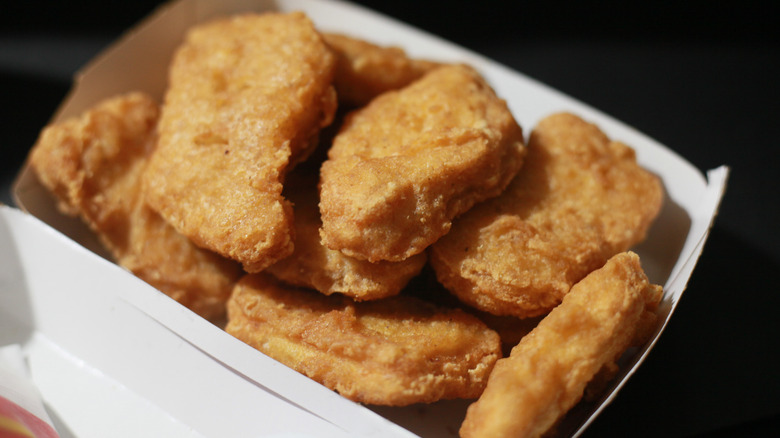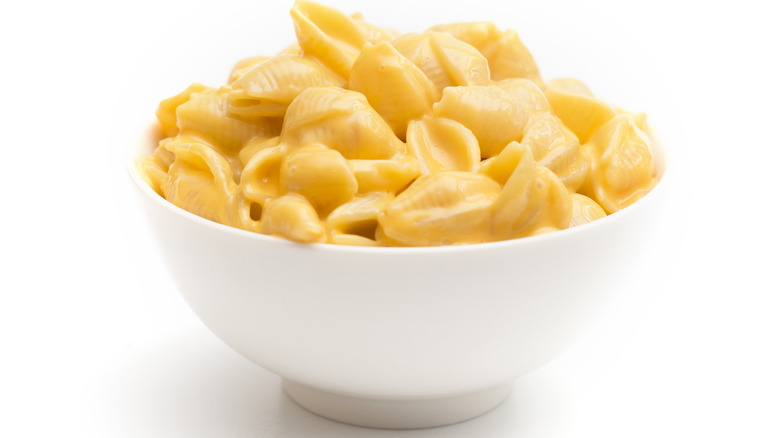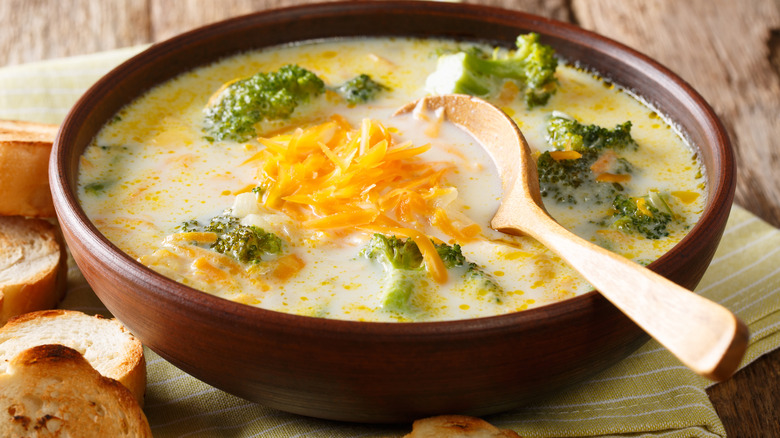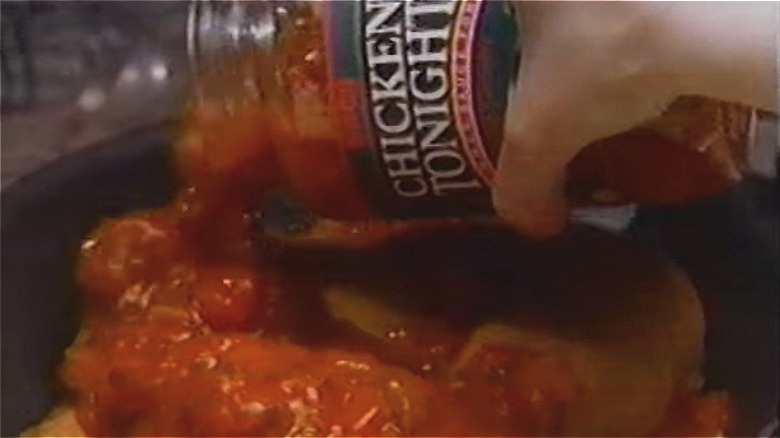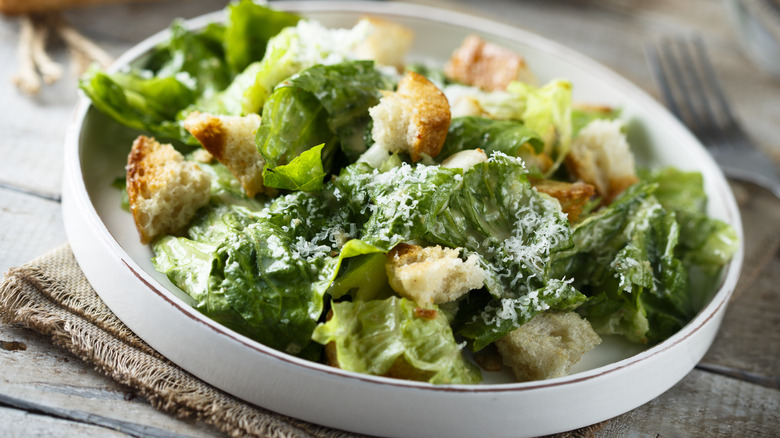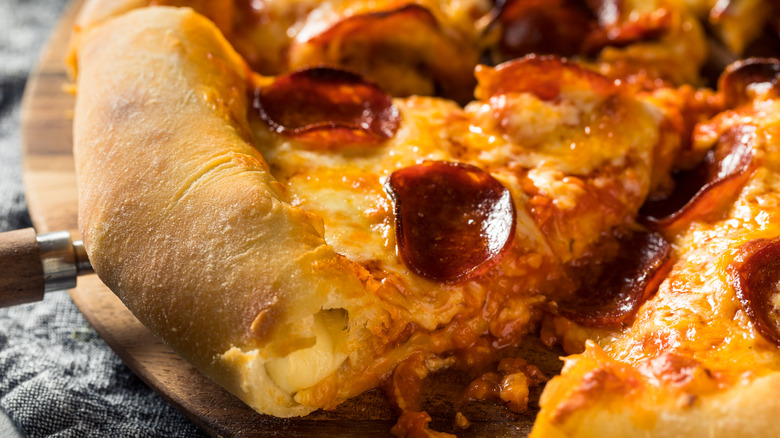What Dinner Looked Like The Year You Were Born
As American life rapidly evolved over the turbulent 20th century, one thing remained constant: Everybody needed to eat. For those who follow the traditional three-meals-a-day diet, dinner is the last meal of the day and often the most important. It's a time to relax with family and decompress from the day while feasting on a hearty, filling, and probably somewhat nutritional meal. What that dinner looked like or consisted of varied greatly from area to area, community to community, and family to family, but certain foods became part of the American culinary canon.
Every favorite dinner was new once, and the choices for what to put on the table have grown. The influence of famous chefs, the media, huge food distributors, trends, fads, newly available ingredients, and inventions have all helped to introduce Americans to new dinner ideas. Here's a look back at some of the biggest and most impactful developments in dinner of the 20th century. What were millions of people likely feasting on throughout the year that you were born?
1970: Quiche
At the dawn of the 1970s, a wide swath of Americans decided that eggs weren't just for breakfast anymore and that a pie didn't have to be the basis for only dessert. According to The Rambling Epicure, in 1970, the quiche became a fashionable, fancy European-inspired option at restaurants and in home kitchens.
Built on a flake pie crust (store-bought or homemade), eggs, cream, and veggies are mixed together, and the whole thing is left to bake until brown and crispy on the sides and brown and bubbly on top. Onions were a popular addition, as were cheeses or spinach, which technically makes the dish a quiche Lorraine.
1971: Beef Wellington
According to Bon Appetit, in 1971, one of the most popular and elegant dishes around was Beef Wellington, an old-fashioned British favorite that begins with steak and winds up an elevated savory pie. It's comfort food — meat and potatoes but turned up a bit.
The entree consists of a steak swathed in mushrooms and/or a chicken liver paté, and then it's all wrapped up in a flaky pastry that turns crispy and brown as the steak cooks inside. Cut into slices to reveal a cross-section of all those perfectly cooked layers. Beef Wellington was most commonly served alongside a heaping pile of mashed potatoes and a healthy serving of gravy.
1972: Fondue
Whether presented as a romantic meal for two or as the centerpiece of a dinner party, fondue is heavily associated with the early 1970s. Introduced to the U.S. at the Swiss Pavilion at the 1964 World's Fair, fondue involves skewering pieces of meat, bread, and vegetables and dipping them into a hot pot of bubbling cheese sauce, generally Raclette, Emmentaler, or Gruyere. Fondue setups at home (kits were a popular gift, according to Smithsonian) or at chains like Melting Pot might include hot oils for additional entree dipping or chocolate fondue for dessert.
1973: Chicken tetrazzini
A big baked casserole that serves as an all-in-one dinner balancing starch, protein, and vegetables is a nostalgically all-American concept. Chicken tetrazzini is just such a dish. According to Quaint Cooking, it's made from diced chicken, mushrooms, a creamy sauce, and a mountain of noodles.
Not an authentically Italian dish or a product of the 1970s ("The New York Times Food Encyclopedia" says it was created in the early 1900s to commemorate an American tour by Italian opera singer Luisa Tetrazzini), it slowly grew in popularity throughout the 20th century. Pitched as a way to use up the previous night's chicken or as a crowd-pleasing dinner party dish, it peaked in popularity in the early 1970s thanks to its inclusion in the bestselling cookbooks "The New New Can-Opener Cookbook" and "I Hate to Cook Book."
1974: Instant mashed potatoes
Mashed potatoes have long been a cheap and hearty dietary staple in the United States, but they're very time-consuming to prepare. Boxes of instant mashed potatoes (dehydrated potato flakes to which water and butter are added) are commonplace in supermarkets today, but they were a huge hit and marvel of food processing technology in the 1960s and 1970s, according to Yahoo.
With a long shelf life, instant mashed potatoes don't require a lot of cooking, chopping, and monotonous stirring. Brands like Smash made it as easy as heating up some liquid and mixing in some white potato chunks. That made mashed potatoes a viable weeknight dinner side dish.
1975: Watergate salad
Watergate was on the minds of many Americans in the 1970s. As the investigation into the 1972 break-in of Democratic National Committee offices in Washington, D.C.'s luxurious Watergate complex heated up (and which would eventually lead to the resignation of President Richard Nixon), the salad or sweet side dish that got its name from a similar cake conceived in the kitchens of the Watergate Hotel, hit dinner tables across the country, per NPR. It's a mint-green concoction made by mixing powdered pistachio pudding mix with a can of pineapple, whipped cream, and chopped nuts.
1976: Chicken Kiev
No, not the block of breaded chicken with the hollowed-out, herbed butter-filled center that comes two to a box and is sold in an obscure corner of a supermarket's freezer section. In the mid-1970s, the exotic-seeming Chicken Kiev (named after the Ukrainian capital, where it probably wasn't invented, per the Evening Standard) was an elegant restaurant entree or the centerpiece of a special meal cooked at home.
Prepared from scratch, it's a complicated dish featuring a boneless chicken breast stuffed with garlic, herbs, and butter that is battered and fried until the butter inside melts. It was customary to serve a portion of Chicken Kiev with some airy, creamy whipped potatoes
1977: Pasta Primavera
While it wound up a common, relatively healthy offering in the form of frozen dinners at the supermarket, pasta primavera was a refreshing, veggie-forward novelty in 1977. According to the New York Times, New York's Le Cirque was the restaurant that put the dish on the map, with a spaghetti primavera loaded with vegetables.
Restaurants everywhere copied the dish, and it seemed so simple that it was easily re-created or approximated at home. Most any kind of pasta could sub for the spaghetti, and any blend of vegetables the maker chooses, fresh or frozen, can be used, although mushrooms and tomatoes were steadfast ingredients in the late '70s. Pasta primavera made the whole year feel like springtime, hence its appeal.
1978: Hamburger Helper
According to Food Processing, one of the biggest American food sensations of the 1970s was Hamburger Helper, a casserole in a box meant to feed a large family. In the box of Betty Crocker-branded dry goods came some large macaroni noodles and a spice packet. It was up to the consumer to add a pound of ground beef and water and put the whole thing in a skillet for a full and balanced meal in about 20 minutes.
The varieties vaguely imitated common flavor profiles and came in "Italian," "Cheesy," and "Mexican." Hamburger Helper was inexpensive and made efficient use of just a little bit of meat during an era when it was sometimes in short supply and inflation was high.
1979: Pasta salad
Filling (but cold), balanced, and combining familiar, readily available ingredients, pasta salad was a refreshing new way to use that tried-and-true staple of dry boxed noodles. Commonly made with long, spiral-shaped noodles that are cooked, cooled, and then tossed with an Italian or similar flavored dressing, pasta salad includes cold veggies like peppers, tomatoes, olives for color and nutrition, and some cheese cubes.
According to Sarasota Bites, when pasta salad started to spread around the U.S. in 1979, it was embraced as a hot-weather dinner, a perfect meal for spring or summer in that it didn't take much cooking beyond boiling some water and wouldn't heat up the kitchen like a hot noodle casserole.
1980: Chicken Francese
Fried and breaded chicken in all of its many forms has always been popular in America. In 1980, one fancied-up version of the cutlet grew extremely popular as restaurant fare (particularly at buffets) and as a home-cooked meal.
According to Food Timeline, Chicken Francese sounds French, but it's more in the Italian-American tradition. The entree is made from a thin, breaded, boneless chicken cutlet that's been fried and then topped with a sauce combining lemon juice, butter, and wine. Comfort food dressed up in an elegant, European-style sauce, it's not unlike chicken piccata, which appears on far more menus now than the lost-in-the-'80s chicken Francese does.
1981: Chicken McNuggets
According to the U.S. Bureau of Labor Statistics, in 1980, the number of women working outside the home rose to the highest level in history to that point — 52 percent. As women, traditionally and historically, were largely responsible for meal preparation in the American household, the kinds of things people ate for dinner started to change because women had less time to spend cooking meals.
Convenience foods took off in a big way in 1981 with the market introduction of two influential and still popular products: Lean Cuisine (low-calorie frozen dinners available in a variety of styles) and Chicken McNuggets (bite-size boneless fried chicken pieces easily obtained from a McDonald's drive-through and marketed to children but enjoyed by consumers of all ages.)
1982: Blackened fish
According to the New York Times, Cajun-style cooking was among the hottest food trends of the early 1980s, specifically blackened redfish. First popularized in 1981 and 1982 by TV chef Paul Prudhomme, who perfected the dish at the famous Commander's Palace restaurant in New Orleans, per the Orlando Sun-Sentinel, the entree got so popular that it appeared on Red Lobster's national menu.
That's just one aspect of the increased demand that led the National Marine Fisheries Service to enact catch limits. Improperly trained restaurant and home cooks alike had trouble executing the dish. Blackened means giving a slight char to the outer, spicy coating on the fish, but many diners wound up with burned fish instead.
1983: Low-salt everything
In 1983, many Americans were less concerned about what they were eating as opposed to what was in what they were eating. That year, according to the New York Times, health-conscious food trends leaned hard into the salt-free and low-sodium lanes, with 37 percent of consumers surveyed by Marketing Research Corporation saying they were on a sodium-restricted diet. Such was the price paid for convenience foods. They're loaded with preserving sodium.
Americans reversed course by 1983, and many of the same companies that had sold such salt-laden fare offered low-sodium alternatives. What was on the table for dinner didn't change much. It was just made with slightly less salty ingredients from companies such as Libby, Del Monte, Smithfield, and Campbell's.
1984: Shells and Cheese
Kraft introduced its Macaroni and Cheese Dinner, a combination of simple elbow noodles and powder-based cheese sauce, in 1937. By the 1980s, with the food taking on a reputation as kids' fare, it needed an update.
In 1984, Kraft introduced Shells and Cheese, a more sophisticated, more refined mac and cheese. Instead of tiny elbow noodles, the pasta was large, round shells, and the cheese came already made in the form of a packet of smooth and creamy Velveeta. No longer would mac and cheese have to be something just for kids or a side dish. Shells and Cheese made this comfort food the main event.
1985: Loaded baked potatoes
In the mid-1980s, conventional wisdom dictated that those who ate healthily ought to avoid fat. Carbohydrate-loaded foods were considered healthy, which led to giant baked potatoes having a moment. Usually served as a side dish with a big piece of meat, the loaded baked potato, piled high with ironically fat-laden cheese, bacon, and sour cream, was a meal unto itself and a fun alternative to the usual dinner fare.
Wendy's helped launch the fad with the 1983 introduction of a health-conscious menu that included different baked potato options. To-go loaded potato spots like Commander Spuds opened across the country, and similarly, potato skins — hollowed-out potatoes topped with the usual baked potato accessories — were an immensely popular restaurant item in the mid-1980s, according to the Chicago Tribune (via Eater).
1986: Chef cookbooks
A massive cultural shift took place in 1986, according to the Chicago Tribune. Americans tried to get a little more elaborate with their home-cooked meals, utilizing higher quality ingredients than in years past and preparing more exotic fare as presented in cookbooks. Such illustrated manuals of eating and entertaining bloomed in popularity in 1986 as home cooks sought to expand their culinary horizons by preparing meals in styles that they weren't necessarily familiar with or had only sampled in restaurants. Among the top-selling and most influential cookbooks of the year were Jeff Smith's "The Frugal Gourmet Cooks with Wine" and "The Frugal Gourmet," John Sedlar's "Modern Southwestern Cuisine," and Nina Simonds "Chinese Seasons."
1987: Microwavable food
The microwave was the definitive, life-changing kitchen appliance of the 1980s. According to the Chicago Tribune, by 1987, the highly scientific rapid-cooking machine had dropped drastically in price from only a few years earlier, and two-thirds of all American homes had one. People weren't necessarily changing what they ate but were rethinking how they cooked.
That year, Campbell's announced that its entire frozen foods line wouldn't include anything that wasn't microwavable, while ready-made, heat-and-eat convenience foods like pizza and pancakes were more widely available in quick-cook, microwavable versions. Americans were using the microwave to prepare meals from scratch, too. Barbara Kafka's 1987 cookbook "Microwave Gourmet" was a bestseller, according to The Guardian.
1988: Pork
According to the Chicago Tribune, the National Pork Producers Council sought to revitalize public opinion of pork to position it as an exciting protein, versatile dinner centerpiece, and a food that fell in line with the cleaner, healthier eating trend that began in the 1970s. In 1987, the group launched an aggressive publicity campaign with the memorable slogan, "Pork... the other white meat."
By comparing itself to lighter fare like poultry, the gambit worked. Pork advocacy and consumption were seemingly everywhere in 1988 and the years after, with restaurants promoting it and grocery stores selling a lot more of it than they had. Within a few years, according to the New York Times, pork sales were up by 20 percent, meaning pork chops and pork loin were a regular dinnertime treat for millions of Americans in 1988.
1989: Ground turkey
Turkey was the definitive meat of the 1980s. According to the Los Angeles Times, beef consumption in the U.S. peaked in the mid-1970s, but as concerns over the link between red meat and devastating health issues sunk in over the next decade, Americans cut down on beef in record numbers and replaced it with lean, low-cholesterol turkey. In 1989, the average American ate 68 percent more turkey than they did in 1980.
Much of that was in the form of ground turkey, a versatile substitute for ground beef in all kinds of home-cooked meals like meatloaf, tacos, spaghetti sauce, and hamburgers. Ground turkey was available in the mid-1980s, but it wasn't until the latter part of the decade that it became a supermarket must-stock item to meet demand. The preparation of turkey-based dinners became very common in 1989, with sales of the ground product growing by 150 percent over the previous year.
1990: Cream of broccoli soup
According to Cook's Info, early in 1990, Campbell's introduced a brand new soup, Cream of Broccoli, first to restaurants and then directly to consumers. Geared toward Baby Boomers experiencing decreased appetite with aging and whose children had grown up and moved out, the soup was prominently featured in a line of heat-and-serve Souper-Combo meals, which included a sandwich. Cream of Broccoli, which Campbell's said was inspired by restaurant soups, came with a ham and cheese croissant.
To encourage sales of just the soup, Campbell's published a free mail-order cookbook and held a recipe contest with a $7,500 prize. All told, Cream of Broccoli was among the best-selling grocery items that year, with 56 million cans bought and consumed.
1991: Chicken Tonight
In 1991, Ragu, best known as a major player in the jarred pasta sauce sector, expanded its product line and helped popularize simmer sauces — jars of already blended ingredients that, when cooked in a pan with chopped meat, created a complete, hot dinner. Launched at the end of 1990, Ragu's "Chicken Tonight" became a fad in 1991 — if only for its ads, which featured happy people flapping their arms like chickens and dancing to a catchy jingle with the repetitive lyrics, "I feel like Chicken Tonight!" (Even the edgy show of the moment, "The Simpsons," referenced the campaign.)
According to Deseret News, Chicken Tonight was very similar to Ragu's pasta-centric sauces and came in varieties like Chicken Cacciatore, Herbed Chicken with Wine, Country French Chicken, and Creamy Chicken with Mushrooms. After its initial burst of popularity in the U.S., Chicken Tonight grew much more popular in the United Kingdom. But in 1991, those endlessly running ads inspired more than a few home cooks to buy a jar of the sauce and pour it over some sliced chicken breasts.
1992: Caesar salad
According to the Washington Post, Marriott placed Caesar salads on the menus at many of its chain restaurants in the mid-1980s, and it became a popular lunch favorite. After its initial pop in stature in 1992, the Caesar salad and the chicken Caesar salad, in particular, grew to ubiquity.
Bottled dressings sold well (according to the New York Times), and sit-down and fast-food restaurants adopted the salad as more and more Americans realized that a Caesar was more than just a side salad. A leafy green lettuce-based dish could be a meal, provided that it was heavily dressed with tangy sauce, parmesan cheese, black pepper, hefty croutons, and maybe some protein.
1993: Pesto
In the early 1990s, Americans far and wide opened up to the idea that there was a third thing after marinara-type sauces and creamy concoctions they could use to cover their noodles to make a quick and easy dinner. That concoction was pesto, made by chopping and blending ground pine nuts, fresh basil, garlic, salt, and olive oil until it reaches a thick consistency and dark green color.
Pesto rode the wave of popularity of Italian food (that wasn't spaghetti and meatballs), helped along by well-received cookbooks like "The Splendid Table." It started to appear pre-made in jars at supermarkets more often, while restaurants (according to the New York Times) thought beyond pasta and used pesto as a sauce and condiment.
1994: Rotisserie chickens
They're a ubiquitous presence in supermarkets now, but they've only been so visible since the mid-1990s. Most any moderately sized or larger grocery store now offers completely cooked rotisserie chickens. Generally priced around $10 or less, they're a quick and easy meal as is or can be cut up and used for any number of chicken-based dishes.
This reliable, last-minute dinner idea is a modern one, with Costco and Kroger both introducing rotisserie-cooked chickens prepared on the premises in 1994, per the Wall Street Journal. Both chains and many others cook and sell millions of them every year.
1995: Stuffed crust pizza
Long entrenched as a crowd-pleasing and crowd-feeding dinner option, pizza dominated the takeout sector by the 1990s. There were countless national and local pizza parlors to choose from. However, Pizza Hut wanted to jump ahead of its competition by offering customers something extra, namely more of the thing that almost everyone likes best about pizza — cheese.
Introduced in 1995, Pizza Hut had an instant hit on its hands with the introduction of the Stuffed Crust Pizza. A long tube of pizza cheese is embedded in the outer ring of the crust and melts upon baking, turning the pizza into a pizza/cheesy-breadstick combo.
